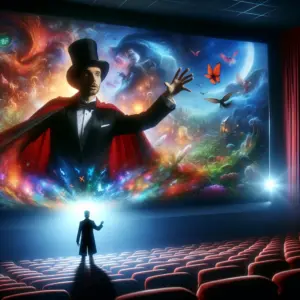Magic and Movies: How Magicians Gave Life to Early Cinema
Magic and movies have a deep connection that goes back to the earliest days of cinema.
In today’s modern world, video has become an integral part of our lives. We see magic performed on platforms like YouTube and Instagram, and we marvel at the incredible tricks created by magicians such as Zach King. However, what many people might not realize is that magicians actually played a significant role in shaping the world of moving pictures. In fact, without the art of magic, cinema would not be where it is today.

The Invention of Cinema
Imagine a world without the ability to record movement. It’s difficult to comprehend, but that was the reality for much of human history. The invention of cinema changed everything. After the famous demonstration of the cinematograph by the Lumiere brothers in Paris, the world was captivated. One reporter even wrote that cinema had the power to make death no longer absolute, as people could now become immortal on screen.
However, the concept of projecting images for an audience was not new. For centuries, people had been using a device called the magic lantern to project painted images or photographs onto a screen. And who were the regular users of the magic lantern? Magicians, of course. They knew how to tell stories with images, so it was only natural that they would embrace cinema when it was invented.
Magic and Movies: The Birth of Trick Films
In 1896, David Devant, one of the most successful magicians in England, witnessed the demonstration of the cinematograph by the Lumiere brothers. He immediately recognized the potential of this new technology and showed it to his business partner, magician John Maskelyne. Devant believed that this was the future of entertainment, and he was right. Soon, short films became a staple of magic shows in England.
Devant even claims to have been the first magician ever recorded on camera. In his film, he produced rabbits from a hat, a classic trick that has become synonymous with magic. Little did Devant know that his decision to sell a projector to Georges Méliès would change the course of cinema history.
Georges Méliès: From Magician to Filmmaker
Georges Méliès, originally a footwear manufacturer in Paris, was so captivated by magic that he quit the shoe business and bought a magic theater. He went all-in, taking a plunge that most magicians wouldn’t dare. But Méliès saw the potential in cinema and purchased a projector from David Devant.
It was while experimenting with this new device that Méliès made a groundbreaking discovery. By stopping the camera, changing the setting, and then restarting the camera, he could create a magical transformation on screen. This technique, known as stop action, was revolutionary, as filmmakers at the time were solely focused on capturing reality.
Méliès embraced the creative possibilities of film and combined them with the art of magic. Over the course of 15 years, he produced over 500 short films, many of which featured elaborate trick effects. His most famous film, “A Trip to the Moon,” became an international success and solidified his place in cinematic history.
Trick Films and the Influence of Magic
Méliès may be the most famous magician-turned-filmmaker, but he was not the only one. Magicians such as Gaston Velle also created their own magical films. These early trick films required meticulous planning and editing, as filmmakers had to physically cut and glue pieces of film together while filming. Despite the primitive techniques, these films give us a glimpse into the world of magic in the early 20th century.
Many filmmakers of the time were either magicians themselves or deeply inspired by magic. The influence of the magic scene and community is evident in the films of the era. For example, “The Vanishing Lady” was filmed in the Theatre Robert-Houdin in Paris, providing a glimpse into what a magic theater and stage looked like in the late 19th century.
Magicians such as T. Nelson Downs, known for his incredible coin productions, inspired similar acts on screen using stop action. The popularity of card and coin manipulation in magic shows translated seamlessly to film.
The Legacy of Trick Films
While trick films enjoyed fame in the early 20th century, they ultimately did not stand the test of time. Méliès believed that the methods behind his trick films should remain a secret, but eventually, these techniques became standard practice for every filmmaker.
Méliès struggled as a businessman, unable to compete with the emerging big studios of the time. He ultimately had to stop filmmaking due to financial difficulties and even sold his beloved magic theater. Méliès was forgotten and fell into obscurity until 1929 when he was finally recognized for his contributions to cinema.
George Méliès, the magician-turned-filmmaker, left an indelible mark on the history of cinema. His creative use of trick effects and his ability to combine magic with the emerging art of cinema paved the way for future filmmakers. Despite his struggles, Méliès will always be remembered as a true visionary.
In Conclusion
Magicians played a vital role in the early days of cinema, giving life to the art form through their innovative use of trick effects. The connection between magic and movies is a testament to the power of creativity and the ability to captivate audiences. Without the influence of magicians like Georges Méliès, cinema as we know it today may not have existed.
Magic and movies have forever been intertwined, each offering a unique form of entertainment that continues to captivate audiences to this day.
